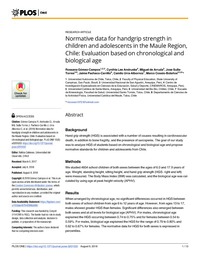Mostrar el registro sencillo de la publicación
Normative data for handgrip strength in children and adolescents in the Maule Region, Chile: Evaluation based on chronological and biological age
| dc.contributor.author | Gómez-Campos, Rossana | |
| dc.contributor.author | Lee-Andruske, Cynthia | |
| dc.contributor.author | De Arruda, Miguel | |
| dc.contributor.author | Sulla-Torres, José | |
| dc.contributor.author | Pacheco-Carrillo, Jaime | |
| dc.contributor.author | Urra-Albornoz, Camilo | |
| dc.contributor.author | Cossio-Bolaños, Marco Antonio | |
| dc.date.accessioned | 2018-11-22T19:06:38Z | |
| dc.date.available | 2018-11-22T19:06:38Z | |
| dc.date.issued | 2018 | |
| dc.identifier.uri | http://repositorio.ucm.cl/handle/ucm/2001 | |
| dc.description.abstract | Background: Hand grip strength (HGS) is associated with a number of causes resulting in cardiovascular death, in addition to bone fragility, and the presence of sarcopenia. The goal of our study was to analyze HGS of students based on chronological and biological age and propose normative standards for children and adolescents from Chile. Methods: We studied 4604 school children of both sexes between the ages of 6.0 and 17.9 years of age. Weight, standing height, sitting height, and hand grip strength (HGS- right and left) were measured. The Body Mass Index (BMI) was calculated, and the biological age was calculated by using age at peak height velocity (APHV). Results: When arranged by chronological age, no significant differences occurred in HGS between both sexes of school children from age 6 to 12 years of age. However, from ages 13 to 17, males showed greater HGS than females. Significant differences also emerged between both sexes and at all levels for biological age (APHV). For males, chronological age explained the HGS occurring between 0.74 to 0.75% and for females between 0.54 to 0.59%. For males, biological age explained the HGS for the range of 0.79 to 0.80% and 0.62 to 0.67% for females. The normative data for HGS for both sexes is expressed in percentiles. Conclusions: HGS during childhood and adolescence needs be analyzed and interpreted in terms of biological age rather than chronological age. The normative data to evaluate the HGS are a tool that can help professionals working in clinical and epidemiological contexts. | es_CL |
| dc.language.iso | en | es_CL |
| dc.rights | Atribución-NoComercial-SinDerivadas 3.0 Chile | * |
| dc.rights.uri | http://creativecommons.org/licenses/by-nc-nd/3.0/cl/ | * |
| dc.source | PLoS ONE, 13(8), e0201033 | es_CL |
| dc.title | Normative data for handgrip strength in children and adolescents in the Maule Region, Chile: Evaluation based on chronological and biological age | es_CL |
| dc.type | Article | es_CL |
| dc.ucm.facultad | Facultad de Ciencias de la Educación | es_CL |
| dc.ucm.indexacion | Scopus | es_CL |
| dc.ucm.indexacion | Isi | es_CL |
| dc.ucm.doi | doi.org/10.1371/journal.pone.0201033 | es_CL |



